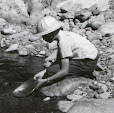 |
| Photo by Eric Ortner from Pexels |
It seems that decades of warfare against mining operations in the U. S. by eco-terrorists in Congress, state legislatures, and the enforcement arms of various agencies has led our country to an untenable position. There are approximately three dozen key minerals that we need to maintain our present level of technology—namely cell phones, computers, solar and wind power systems, etc. At the same time, the majority of federal lands have become off-limits to mineral exploration and development.
A key example of this situation is what has happened to placer mining for gold, in particular concerning the use of the motorized suction dredge. This one device is surely the most effective and efficient way to recover gold from stream-bed deposits. Over the years, state agencies—notably here in Washington—have placed limits on its employment. First, came restrictions on the physical characteristics of the machine itself—nozzle size, intake screen specifications, etc. Later, restrictions were placed on precisely when and where it could be used. Then, there were the permits—Hydraulic Project Authorizations (or HPAs)—that the operator needed to acquire. Finally, the use of the suction dredge was limited to those portions of those streams that are known to carry NO gold. In this way, the use of the motorized suction dredge was effectively outlawed without the need to enact such a law.
These developments bring us to the situation we face today. Although the anti-mining agenda is still in full swing, the changing mineral needs of our society may well soon force a change in mining policy. Not only do we need the specialty minerals mentioned above to maintain our existing technologies, but they will be even more necessary if the leftists' loony visions of a "green energy" and "zero-carbon" future are to have any chance of happening at all. Moreover, the need for domestic production of these minerals is underscored by the fact that we are currently dependent on an increasingly hostile China for these resources. And, while other countries also produce these materials, many are also politically unstable, and none too friendly either. Thus it seems there is a possible future for the small-scale miner in prospecting for things other than gold.
Now, lest you think that your poor, old blogger has gone "green-in-the-head," and now embraces the pie-in-the-sky nonsense of so-called "renewable energy" touted by wokesters, leftists, and their assorted fellow travelers, I wish to assure you that is not the case. But, when fate hands you a winning lottery ticket, you'd be a fool not to cash it in. So, with that caveat out of the way, allow me to proceed.
The minerals deemed necessary for the continued security of the United States are, according to the U. S. Geological Survey, the following:
Aluminum
Antimony
Arsenic
Barite
Beryllium
Cesium
Chromium
Cobalt
Fluorspar
Gallium
Germanium
Graphite
Hafnium
Helium
Indium
Lithium
Magnesium
Manganese
Niobium
Platinum group metals*
Potash
Rare earth elements group**
Rhenium
Rubidium
Scandium
Strontium
Tantalum
Tin
Titanium
Tungsten
Uranium
Vanadium
Zirconium
* The Platinum group metals consist of the elements Platinum, Palladium, Osmium, Iridium, Ruthenium, and Rhodium.
** The Rare earth elements group consists of the elements Scandium, Yttrium, Cerium, Dysprosium, Europium, Lanthanum, Neodynium, and Terbium.
A wealth of detailed information about these minerals is available through the links in the list at the USGS web page here.
While not as obvious to the eye nor as "easy" to locate as gold, the above minerals DO occur and CAN be found by prospectors who make the effort to educate themselves accordingly. Some of the links in the right-hand column of this blog will be of help in researching, identifying, and locating deposits of these minerals, both in Washington and elsewhere. For example, a search of the Mineral Resources Data System for occurrences of Beryllium in Washington returns 26 matches. A similar search for Zirconium returns 15 matches. Information related to mineral properties and identification can be found at the links for Mindat.org and the Mineralogy Database.
Although the WSM has been primarily focused on prospecting for and recovering placer gold—and that will continue to be the case—it is my intent to, from time to time, include articles on prospecting for other elements and minerals.

No comments:
Post a Comment